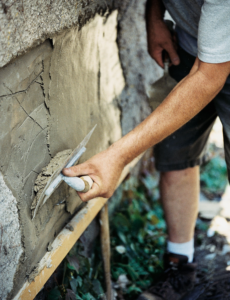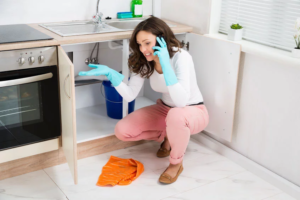A professional can inspect a stucco wall to determine if there are any underlying issues that require remediation. This includes areas where the stucco appears wet or swollen.
Experienced DIYers can patch minor cracks and holes themselves, but homeowners should never ignore underlying damage. Failure to address underlying problems can lead to more expensive repair costs later. Contact Stucco Repair Philadelphia now!

Stucco is a very durable material, but it is not impervious to water damage. Moisture is one of the biggest threats to stucco, and it can cause everything from cracking to mold. It’s important to keep an eye out for any signs of moisture intrusion so that it can be addressed quickly before the damage gets worse.
Some of the most common signs of moisture damage in stucco include musty odors, mold, and bubbling or blistering. If you see any of these issues on your stucco, it’s important to contact a professional for inspection and repair right away.
A professional can inspect the damage to determine if it’s merely surface or if the moisture has penetrated deeper layers of the stucco. A moisture meter can be used to check for trapped water that could lead to mold or further deterioration.
If the damage is only on the surface layer, a simple patching may be sufficient. If the moisture has gone further into the brown coat or even the lath (the mesh framework on which the stucco is applied), a more comprehensive repair may be necessary.
In some cases, the best solution is to completely remove and replace the existing stucco. This is especially true if the damaged area has mold or other structural concerns.
It’s also crucial to ensure that the area is properly prepared before beginning the stucco repair process. This includes thoroughly cleaning the damaged area, removing any dirt or debris, and covering surrounding areas with plastic sheeting. This will prevent any accidental splatters of stucco mix or other repair materials from damaging windows, doors, trim, plants, and any other surfaces that should be left unaffected.
Taking the time to assess the damage and understanding the full range of issues that might be involved can help you decide whether repair or remediation is the best option for your home. While it may be tempting to skip the inspection and proceed with a patching job, this can actually make the situation much worse in the long run. Moisture intrusion in the stucco needs to be addressed before it causes more extensive damage and leads to mold or other structural problems.
Harsh Weather Conditions
Although stucco is a durable material, harsh weather conditions can still damage it. Extreme heat and cold, changing humidity levels, heavy rains, wind and ice can all affect the integrity of the finish. Untreated, these problems can lead to cracking and discoloration, causing water intrusion behind the surface that can result in mold, wood rot and other structural issues.
If a homeowner spots signs of moisture or other damage, it is important to contact a professional contractor right away. Waiting may lead to further damage or even the loss of the entire wall system. Stucco is easy to repair, so long as the problem is caught and addressed quickly. Signs of moisture damage include long, thin cracks, stains or spots of discoloration, and chips or chunks that have come loose from the wall. If a homeowner notices these issues, they should get the area checked out by a contractor to prevent further damage and make sure that water is not leaking behind the stucco.
Moisture is stucco’s kryptonite, and it can cause a number of serious problems. It can lead to a variety of structural issues, including warping and cracking, and it can also create a breeding ground for bacteria that can contribute to both mold and rot. Moisture problems can also impact the underlying framing, leading to further structural damage and expensive repairs.
Stucco can be prone to hairline cracks and other surface flaking, but this is not necessarily a sign of trouble. In many cases, these minor issues can be corrected with a simple application of joint compound. However, if these cracks are caused by structural movement or an issue with the lath that supports the stucco, they may need to be repaired from the inside out through a process known as replastering.
To ensure that the stucco is properly prepared for replastering, it should be covered with plastic sheeting before work begins. This will prevent accidental splatters from the stucco mix or other materials that may be used during the repair process. It is also a good idea to cover any windows, doors or trim with the plastic sheeting.
Poor Maintenance
Stucco is a type of plaster that’s used as an exterior finish for homes. It’s made from cement, sand, and water, and applied wet before it hardens to a very dense solid. It’s a popular material for residential construction because of its durability, aesthetic appeal, and ability to withstand various weather conditions. Like any other exterior finish, stucco requires regular inspections and maintenance to ensure the long-term integrity of the structure. Failure to take proactive steps can result in significant damage and expensive repairs.
The most common problems that affect stucco are moisture intrusion, cracks, and discoloration. Moisture infiltration can be caused by soil settlement, foundation settling, or seismic activity. It may also occur as a result of improper installation practices, such as inadequate mixing of materials or insufficient curing time between coats. If left untreated, moisture intrusion can destroy the stucco and underlying building components, leading to structural damage and interior mold growth.
Cracks are a common problem that affects stucco, and can be caused by many factors. Small cracks can be repaired with a high-quality caulking or patching compound, which will help to prevent further damage and stop water infiltration. If the cracks are extensive, it may be necessary to replace the affected section of the stucco.
Discoloration is another common problem that affects stucco, often resulting in stains or chalky white deposits. This is known as efflorescence, and it’s a clear indication that there’s an underlying issue with moisture. This can lead to the delamination of the stucco, causing it to separate from the underlying masonry. If left untreated, this can lead to structural issues and even a complete collapse of the structure.
Bubbling or blistering stucco surfaces are also signs of moisture buildup. This can be caused by improper drainage, poor sealing, or prolonged exposure to heavy rain without proper protection. This is generally a sign that the stucco has become saturated and requires immediate professional repair. Moisture can be reduced by improving ventilation or reapplying a high-quality sealant.
It’s important to hire a professional for any stucco repair work. They will be able to assess the damage and provide a cost-effective solution that’s tailored to your specific needs. Stucco professionals are also skilled at working at elevated heights, which reduces the risk of injuries and accidents.
Poor Installation
Poor stucco installation is a common issue that blindsides homeowners. It manifests in a variety of ways, from unsightly cracking and color inconsistencies to severe water intrusion and structural damage. Thankfully, these issues can be corrected with the help of experienced and knowledgeable professionals.
It is important to hire only certified stucco specialists who are knowledgeable and qualified to perform quality work. This ensures that any repairs or installations done are of the highest possible standards. A good stucco specialist will know the most effective and lasting methods for repairing problems with EIFS systems, avoiding costly mistakes that could jeopardize the integrity of the system.
The type of materials used in a repair job also has an impact on the success of the project. For example, if the wrong type of lime is used to make a repair, it can cause more damage by accelerating the deterioration of the existing system. This is why only the best materials should be used for stucco repair. It is advisable to choose a softer lime that has the same characteristics as the original stucco. In addition, a washed and graded pit sand should be used that is free of clay and organic impurities.
Other signs of poor stucco repair include peeling paint or wallpaper, which may indicate that moisture is penetrating into the system. This is a serious problem that can affect both the structural integrity of the home and the health and comfort of its inhabitants. If this is the case, it is necessary to correct the underlying issue in order to restore the function and beauty of the stucco system.
Incorrectly installed doors, windows, and vents can also contribute to the failure of EIFS systems. It is vital that these junctures are properly sealed and reinforced with the appropriate materials to avoid leaks and other structural problems. This can be achieved by using high-quality sealants and by ensuring that all joints are properly caulked.
Other issues that can be a result of bad EIFS repair jobs are mold, mildew, and dry rot. If any of these symptoms occur, it is a good idea to consult with a professional who specializes in EIFS repairs immediately.
